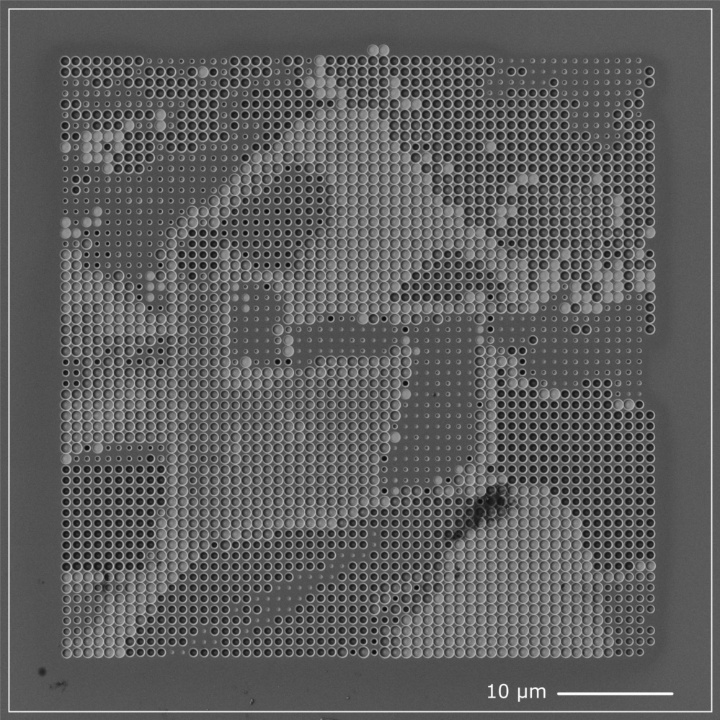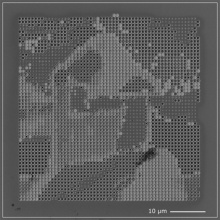Shrink a painting to the width of a hair and still reproduce all the colors true to the original? Dr. Mario Hentschel from the 4th Physics Institute at the University of Stuttgart succeeded in doing this. The physicist structured Kandinsky's "Improvisation 9" using ion beam lithography – a structuring technique from semiconductor industry – onto an area of 180 x 180 square micrometers. Under the microscope, new opportunities emerge for preservation of art works as well as for applications in nanophotonics, sensing and semiconductors technology. Interested visitors and school classes can find out how art and physics come together in the world's smallest Kandinsky in the Staatsgalerie Stuttgart until December 3rd, 2023.
Colors arise from the reflection or absorption of light. As simple as this may sound, it is a real challenge to artificiality reproduce the entire color palette. Nanophotonic structures with resonances in the ultraviolet, green or yellow spectral range (or structures that show these colors) are difficult to achieve, hampering important applications in sensor technology and nanophotonics. Dr. Mario Hentschel from the 4th Physics Institute at the University of Stuttgart has come across a possibility that will change this.
Physicist traps light in air
The Stuttgart physicist has managed to trap light in thin air instead of solid material. "Materials such as silicon are non-transparent and therefore absorb a lot of light," explains Hentschel. "We discovered that we can reverse the trapping mechanism and circumvent loss." Since air is transparent and absorbs almost no light, the new concept allows to unlock previously inaccessible frequency ranges. This opens up new possibilities, for example for the production of microchips and camera lenses, the design of security features, for example for credit cards, and for biomedical analysis of cell tissue. It might also be possible to preserve nanoscale versions of art works, perverting color fading over time.
Physics meets art
To demonstrate his discovery in all its colorful splendor, Hentschel used ion beam lithography to structure Wassily Kandinsky's "Improvisation 9" onto a silicon wafer – a basic material in microelectronics and chip manufacturing. A focused gold ion beam, similar to a jet of sand or water from a nozzle, removes material directly from the surface. This "gold sandblast" digs cone-shaped holes in the silicon wafer in which light of a specific wavelength resonates, determined by depth and diameter. Each of the holes forms a pixel of the image, giving the Mini Kandinsky an almost unimaginable resolution of 36,000 dpi (dots per inch).

"What happens in a single hole can be compared to the phenomenon known from the dome of St. Paul's Cathedral in London", explains Hentschel. "You can hear a person loud and clear from across the dome, as if you were standing right next to them. This is because the sound travels along the dome wall, forming a standing wave, like the vibrations on the string of a violin. For the silicon nanoholes the situation is very similar as light moves along the interface between the silicon and the air inside the hole."
The colors are only visible under the microscope, as the copy of the Kandinsky painting measures just 180 x 180 square micrometers – for comparison, a human hair is approximately 80 micrometers thick. The mini version thus fits almost 40 million times into the original painting which has a size of 110 x 110 square centimeters.
Mini-Kandinsky exhibited in the Staatsgalerie next to original
The mini Kandinsky will be displayed next to the original painting in the Staatsgalerie Stuttgart until December 3rd, 2023. The exhibition is a cooperation between the Staatsgalerie, the University of Stuttgart and the Carl Zeiss AG, providing the optical microscope for visualization. Together with the curator Hendrik Bündge, Hentschel offers guided tours – both to Kandinsky's work and to its nanoscale copy. School classes from the upper levels of technical high schools and advanced physics courses have free entry. You can find more information about the tour and the accompanying exhibition in the October monthly program of the Staatsgalerie Stuttgart.
- October 10, 2023, 10:15 a.m. to 11:15 a.m.
- October 12, 2023, 5:00 p.m. to 6:00 p.m.
| Contact | Dr. Mario Hentschel, University of Stuttgart, 4th Physics Institute |
|---|




